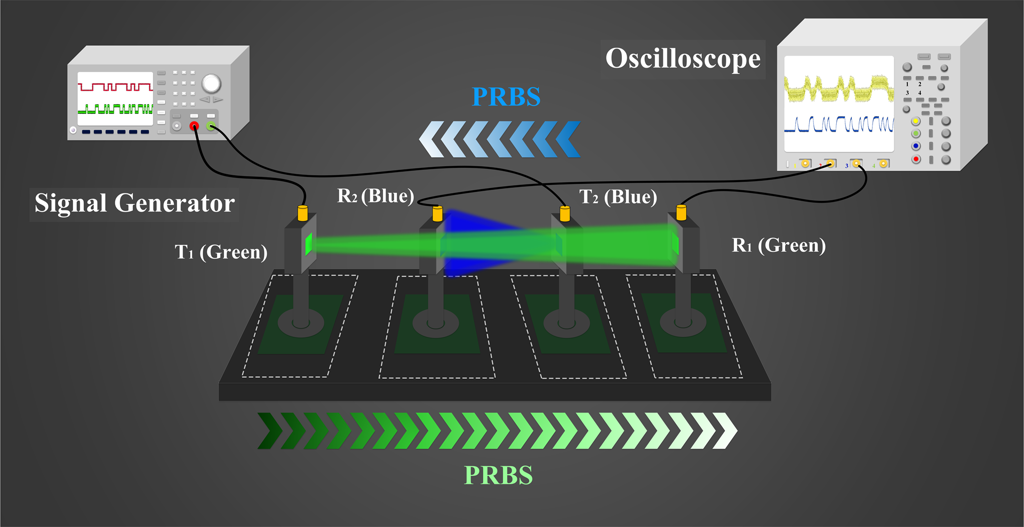New multi-channel visible light communication system uses single optical path
About Optica
14 September 2022
New multi-channel visible light communication system uses single optical path
New design saves cost and space, could lead to compact light-based computer processors
WASHINGTON — Researchers have demonstrated a new visible light communication system that uses a single optical path to create a multi-channel communication link over the air. This approach could be used as a backup communication link or for connecting Internet of Things devices.

Caption: Researchers created a multichannel communication system using a single optical path. It contains blue emitting MQW III-nitride diodes placed between two green diodes in a single optical path. A coating on each diode chip blocked blue light while letting the green light through, creating separate green and blue optical paths. T: transmitter, R: receiver, PRBS: pseudo random bit sequence.
Image Credit: Yongjin Wang, Nanjing University of Posts and Telecommunications
“Today’s free-space optical communication systems typically use two separate links with separate optical paths to establish two channels,” said research team leader Yongjin Wang from Nanjing University of Posts and Telecommunications in China. “This new communication mode can save half the channel space, cost and power by using a single link.”
The researchers describe their new approach in the Optica Publishing Group journal Optics Letters. It is based on devices called multiple quantum well (MQW) III-nitride diodes that can emit and detect light at the same time.
“This technique could enable light-based communication functions to be highly integrated onto a chip, which could also be used to reduce the size of circuit boards, making them cheaper and more portable,” said Wang. “Eventually we would like to develop a photonic CPU based on this communication mode.”
Canceling crosstalk
MQW III-nitride diodes are chip-based devices that feature an overlapping region between the wavelengths they emit and detect. This allows them to be simultaneously used as both a transmitter and a receiver in a wireless light-based communication system. These diodes also feature a variety of light emission, transmission, modulation and detection functions that make them useful for this application.
In the new work, the researchers used blue and green emitting MQW III-nitride diodes to create a single-link communication system that can transmit and receive information on more than one channel. This required figuring out how to stop crosstalk from occurring between the different optical signals.
They accomplished this by designing a setup with two blue emitting MQW III-nitride diodes placed between two green diodes in a single optical path. Each diode chip was coated with a distributed Bragg reflection (DBR) coating that blocked blue light while letting the green light through. This created a green optical path with one green diode acting as a transmitter and one as a receiver while the blue light stayed between the blue diode transmitter/receiver pair.
Demonstrating two channels
To test the system, the researchers carried out various types of optical characterizations. For example, they showed that when the blue diode functioned as a transmitter, light emission increased as the injection current increased from 10 mA to 30 mA, converting the energy and information from electrical into optical domain. They also demonstrated that the emission and detection spectrums of the blue light chip overlapped by about 37 nm, confirming simultaneous emission and detection. Overall, these tests confirmed that a single-optical path full-duplex optical communication link could be stably formed using two pairs of MQW III-nitride diodes, delivering a data rate of 100 bits per second.
“Through this new communication mode, we showed the saving of channel space and cost and the high integration of communication,” said Wang “This is of great significance to the miniaturization and integration of photonic chips in the future.”
The researchers are now working to better understand the simultaneous emission and detection properties of MQW III-nitride diodes to make optoelectronic chips that are even more integrated and multifunctional. They are also working to improve the detection capabilities of the new communication system.
Paper: Paper: K. Fu, X. Gao, Q. Yin, J. Yan, X. Ji, Y. Wang, “Full-duplex visible light communication system using a single channel,” Opt. Lett., 47,18, 4802-4805 (2022).
DOI: https://doi.org/10.1364/OL.470796
About Optica Publishing Group
Optica Publishing Group is a division of the society, Optica, Advancing Optics and Photonics Worldwide. It publishes the largest collection of peer-reviewed and most-cited content in optics and photonics, including 18 prestigious journals, the society’s flagship member magazine, and papers and videos from more than 835 conferences. With over 400,000 journal articles, conference papers and videos to search, discover and access, our publications portfolio represents the full range of research in the field from around the globe.
About Optics Letters
Optics Letters has been publishing high-impact research in the field of photonics for over 45 years and offers rapid dissemination of new results in all areas of optical science with short, original, peer-reviewed communications. Optics Letters accepts papers that are noteworthy to a substantial part of the optics community. Published by Optica Publishing Group and led by Editor-in-Chief Miguel Alonso, Institut Fresnel, École Centrale de Marseille and Aix-Marseille Université, France, University of Rochester, USA. For more information, visit Optics Letters.
Media Contact
